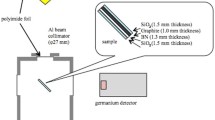Abstract
An elemental analysis method utilizing muons has been demonstrated to be effective for non-destructive and quantitative analysis of precious bulk materials. In muon capture process, molecular structure dependence was known, and this property has the potential to be used to identify chemical structure in addition to elemental composition. Before these potential applications, fundamental studies examining the muon capture process are necessary. In this study, muon capture ratios for two iron oxide compounds, which are both important in earth science, γ-Fe2O3 (maghemite) and Fe3O4 (magnetite), were measured. The measured muon capture ratios were A(Fe/O) = 2.34 ± 0.03 and A(Fe/O) = 2.77 ± 0.03 for γ-Fe2O3 and Fe3O4, respectively.


Similar content being viewed by others
References
Ninomiya K (2019) Non-destructive, position-selective, and multi-elemental analysis method involving negative muons. J Nucl Radiochem Sci 19:8–13
Ninomiya K, Nagatomo T, Kubo K, Ito TU, Higemoto W, Kita M, Shinohara A, Strasser P, Kawamura N, Shimomura K, Miyake Y, Saito T (2012) Development of nondestructive and quantitative elemental analysis method using calibration curve between muonic X-ray intensity and elemental composition in bronze. Bull Chem Soc Jpn 85:228–230. https://doi.org/10.1246/bcsj.20110151
Terada K, Ninomiya K, Osawa T, Tachibana S, Miyake Y, Kubo MK, Kawamura N, Higemoto W, Tsuchiyama A, Ebihara M, Uesugi M (2014) A new X-ray fluorescence spectroscopy for extraterrestrial materials using muon beam. Sci Rep 4:5072. https://doi.org/10.1038/srep05072
Ninomiya K, Kubo MK, Nagatomo T, Higemoto W, Ito TU, Kawamura N, Strasser P, Shimomura K, Miyake Y, Suzuki T, Kobayashi Y, Sakamoto S, Shinohara A, Saito T (2015) Nondestructive elemental depth-profiling analysis by muonic X-ray measurement. Anal Chem 87:4597–4600. https://doi.org/10.1021/acs.analchem.5b01169
Schellenberg L, Robert-Tissot B, Käser K, Schaller LA, Schneuwly H, Fricke G, Glückert S, Mallot G, Shera EB (1980) Systematics of nuclear charge radii of the stable molybdenum isotopes from muonic atoms. Nucl Phys A 333:333–342. https://doi.org/10.1016/0375-9474(80)90100-1
Ninomiya K, Kudo T, Strasser P, Terada K, Kawai Y, Tampo M, Miyake Y, Shinohara A, Kubo MK (2019) Development of non-destructive isotopic analysis methods using muon beams and their application to the analysis of lead. J Radioanal Nucl Chem 320:801–805. https://doi.org/10.1007/s10967-019-06506-9
Terada K, Sato A, Ninomiya K, Kawashima Y, Shimomura K, Yoshida G, Kawai Y, Osawa T, Tachibana S (2017) Non-destructive elemental analysis of a carbonaceous chondrite with direct current Muon beam at MuSIC A new X-ray fluorescence spectroscopy for extraterrestrial materials using muon beam. Sci Rep 7:15478. https://doi.org/10.1038/s41598-017-15719-5
Hampshire BV, Butcher K, Ishida K, Green G, Paul DM, Hillier AD (2019) Using negative muons as a probe for depth profiling silver roman coinage. Heritage 2:400–407. https://doi.org/10.3390/heritage2010028
Ninomiya K, Ito TU, Higemoto W, Kawamura N, Strasser Pm Nagatomo T, Shimomura K, Miyake Y, Kita M, Shinohara A, Kubo MK, Miura T (2019) Negative muon capture ratios for nitrogen oxide molecules. J Radioanal Nucl Chem 319:767–773. https://doi.org/10.1007/s10967-018-6366-3
Schneuwly H, Pokrovsky VI, Ponomarev LI (1978) On Coulomb capture ratios of negative mesons in chemical compounds. Nucl Phys Sect A 312:419–426. https://doi.org/10.1016/0375-9474(78)90601-2
Imanishi N, Miyamoto S, Takeuchi Y, Shinohara A, Kaji H, Yoshimura Y (1988) Chemical-bond effect of pion-capture ratios in some alkali-metal compounds. Phys Rev A 37:43–48. https://doi.org/10.1103/PhysRevA.37.43
Yoshida G, Ninomiya K, Inagaki M, Higemoto W, Strasser P, Kawamura N, Shimomura K, Miyake Y, Miura T, Kubo MK, Shinohara A (2019) Initial quantum levels of captured muons in CO, CO2, and COS. J Radioanal Nucl Chem 320:283–289. https://doi.org/10.1007/s10967-019-06470-4
Cook S, D'Arcy R, Edmonds A, Fukuda M, Hatanaka K, Hino Y, Kuno Y, Lancaster M, Mori Y, Ogitsu T, Sakamoto H, Sato A, Tran NH, Truong NM, Wing M, Yamamoto A, Yoshida M (2017) Delivering the world’s most intense muon beam. Phys Rev Accel Beams 20:030101. https://doi.org/10.1103/PhysRevAccelBeams.20.030101
Hartmann FJ, Egidy T, Bergmann R, Kleber M, Pfeiffer HJ, Springer K, Daniel H (1976) Measurement of the muonic X-ray cascade in metallic iron. Phys Rev Lett 37:331–334. https://doi.org/10.1103/PhysRevLett.37.331
Hirayama H, Namito Y, Bielajew AF, Wilderman SJ, Nelson WR (2005) The EGS5 code system. SLAC-Report 730
Stanislaus S, Entezami F, Bagheri A, Measday DF, Garner D (1987) Atomic capture ratios for muons in oxides. Nucl Phys A 475:630–641. https://doi.org/10.1016/0375-9474(87)90229-6
Egidy T, Denk W, Bergmann R, Daniel H, Hartmann FJ, Reidy JJ, Wilhelm W (1981) Muonic Coulomb capture ratios and X-ray cascades in oxides. Phys Rev A 23:427–440. https://doi.org/10.1103/PhysRevA.23.427
Schneuwly H, Boschung M, Kaeser K, Piller G, Ruetschi A, Schaller LA, Schellenberg L (1983) Capture of negative muons in cubic and hexagonal structures of carbon and boron nitride. Phys Rev A 27:950–960. https://doi.org/10.1103/PhysRevA.27.950
Stanislaus S, Entezami F, Bagheri A, Measday DF, Garner D (1987) Atomic capture of muons and density. Nucl Phys A 475:642–656. https://doi.org/10.1016/0375-9474(87)90230-2
Acknowledgements
This research was supported by the Grant-in-Aid for Scientific Research C (18K11922) and Grant-in-Aid for Scientific Research on Innovative Areas (18H05457). The muon beam experiment at the MuSIC-M1 beamline in RCNP was conducted as E529 experiment in RCNP proposal number.
Author information
Authors and Affiliations
Corresponding author
Additional information
Publisher's Note
Springer Nature remains neutral with regard to jurisdictional claims in published maps and institutional affiliations.
Rights and permissions
About this article
Cite this article
Ninomiya, K., Kajino, M., Inagaki, M. et al. Per atom muon capture ratios and effects of molecular structure on muon capture by γ-Fe2O3 and Fe3O4. J Radioanal Nucl Chem 324, 403–408 (2020). https://doi.org/10.1007/s10967-020-07065-0
Received:
Published:
Issue Date:
DOI: https://doi.org/10.1007/s10967-020-07065-0




